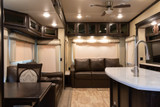Welcoming Your Cat To The RVing Lifestyle
Camping and dogs seem to fit together well, but there is another favorite family pet that should not be left out – your cat. While cats do well on their own when left at home for shorter durations, taking them from a familiar environment for the great unknown in an RV may be challenging. For many cat people, however, there is no choice here; their cats need to be by their side, enjoying the sights and smells of exploring new places.
Cats by nature are curious and a bit skittish when it comes to the unfamiliar. That is why the number one first step is to get your cat used to traveling in a vehicle. Like many pets, a trip in the car can become associated with unpleasant things, like a visit to the vet. Displace that negative association with positive ones, like short trips in the car and eventually the RV into longer trips.
Teaching your cat to accept a leash is another must-do. It is difficult to train cats to walk on a leash like their canine counterparts. That is more about the cat’s innate independent streak than about a pet owner’s dedication. Cats can learn to be coaxed along while on a leash, with a harness securely attached, but it takes patience on the human’s part. Be prepared for a lot of stops to smell the plants, the dirt, the trees, etc. and for a few chomps at grass and other plants. Cats do like to graze a bit.
One suggestion to help harness train your cat is to put the harness on while safely at home. Letting the cat roam around in familiar surroundings while wearing the harness makes the experience of putting one on to go outside much easier. Unlike leashes that attach to a collar, a harness keeps your cat from pulling loose and running away, which would be devastating for any cat owner.
When it comes to harnesses, one suggestion is to choose one that fastens around the cat much like a life jacket for boaters does. With wide straps and hook-and-eye closures, it is secure enough to thwart any escape attempt. Cats can easily give conventional leash-harnesses the slip and these are much harder to adjust and put on then the jacket-like ones.
Getting a cat accustomed to being inside their crate while traveling is also important. Crates offer security in the event of an accident or roadway mishap. It also can become your cat’s safe place when the RV is moving. Cats seek out cave-like hiding places for that instinctual reaction to scary or unknown situations. Much like a cat that hides under a bed when a stranger comes calling or when heading into the basement rafters when a danger is perceived entering the house (like the patter of canine paws on the floor), a crate can become their safe space.
When in the crate and on the road, one helpful suggestion is to line the crate with disposable pads that give your cat a soft place to sleep but also is convenient when having to clean up after car sickness or an anxiety-induced bowel movement. Keep harness and leash handy when making stops because it is beneficial to let the cat out of the crate occasionally.
Another consideration is making sure your cat has everything it needs for life on the road. This includes finding a place for the litter box. Most cat owners who are experienced RVers suggest using the shower as the go-to place for the litterbox. The shower keeps the box secure from the motion of the RV and is an easy place to clean up. It is a good idea to make sure the litter you choose to use is one that the cat is familiar with, perhaps even the same one they would use at home.
Ensure that your cat has access to food and water. When traveling, it is recommended that cats travel better on an empty stomach, but water is essential. Once set up at camp, cats need access to their food too. One suggestion is to use a lower-level drawer to store the pet dishes which means these dishes can be put away when traveling. When stationary, the drawer is pulled open and the hungry cat can be fed at this designated location. Cats are creatures of habit and the more ways you can keep things the same, the happier your pet will be.
You like spending time outside the RV, and your cat will too. Opt for an enclosure suitable to cats to be used outside the RV. This enclosure is designed to secure your cats but give them the freedom to experience the sights, sounds and smells of the environment around them. It lets them off-leash and harness and outside with their humans.
Another possibility for taking your cat with you on hikes or outside excursions is a specially designed backpack that allows the cat to see out with mesh to allow breathing. Just like humans, some cats may enjoy this, and others may think it’s the human’s latest torture device, so try it out before deciding to use this route.
Find a spot in the RV that your cat enjoys. Creating a comfy sunny spot to look out the window can keep a cat occupied for hours. Engaging any animal is essential to their emotional and physical health. If they have favorite toys at home, be sure to bring these along. Familiarity is the cat’s best friend.
Thinking like your cat is the key to making RVing as enjoyable for your cat as it is for you. While this is not always easy given the elusive nature of the feline, it can help ease anxiety and keep those purrs coming.
Recent Posts
-
How To Keep RV Furniture From Peeling
Peeling RV Furniture | Why it Peels and How to Stop it Your RV furniture is a point of pride on …Apr 23rd 2024 -
4 Tips for Securing RV Furniture While Traveling | RecPro
How To Secure RV Furniture There are few things that beat going out on an adventure with an RV …Apr 11th 2024 -
Can You Put Regular Furniture in an RV?
Can you put regular furniture in an RV? Many new and old RV owners ask themselves this qu …Apr 8th 2024 -
Are RV Electric Fireplaces Safe
Being Safe in Your RV with an Electric Fireplace Safety is always going to be one of your highest …Apr 4th 2024 -
How To Install An RV Fireplace
A Warm Addition to Your On-Wheels: The DIY RV Fireplace Installation Guide Many RV enthusiasts ask …Apr 1st 2024 -
Essential Grilling Gear Every RVer Needs
Whether or not you consider yourself a pitmaster or grillmaster, if you’re out on the road with y …Mar 18th 2024







